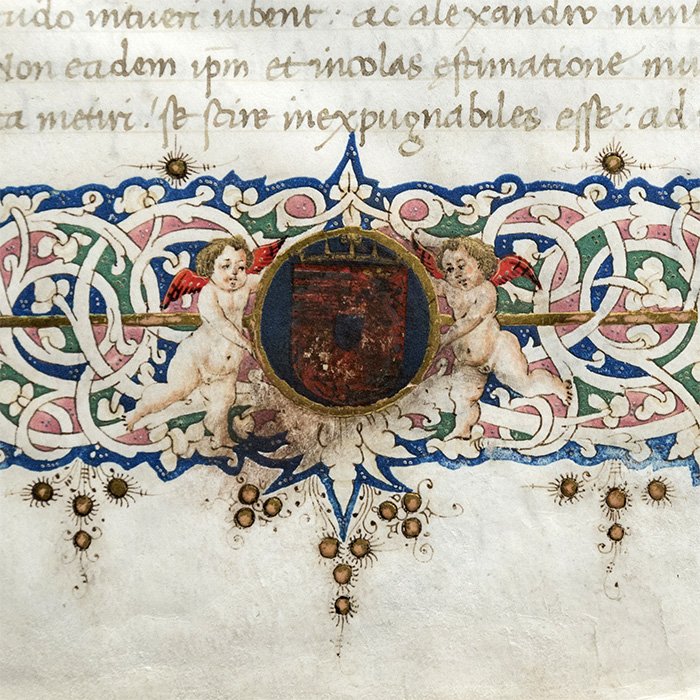Curtius Rufus: De gestis Alexandri Magni
The biography of Alexander the Great by Roman historian Curtius Rufus (1st century CE) was a popular read in the Middle Ages. The bravery and force of the world-conquering military leader was an archetype for the idealized figure of the medieval knight and of course the Renaissance prince. (His hubris and moral corruption, on the other hand, and also described by literature, could serve as a deterring example.) The idealized image has been preserved by Hungarian Renaissance literature. A work by Andreas Pannonius written to King Matthias compares Matthias’s father Johannes Hunyadi to Alexander the Great, Gaspar Heltai in his chronicle of 1574 compares to him the very Matthias: “Before them [his soldiers] King Matthias was like an Alexander the Great.”
This volume made in Florence is one of the rare Corvinas that were signed by the copyist (in this case Piero Cennini) at the end of the text. The decoration is also Florentine work, but the leather binding was already made in Buda in the style of the Corvinas. (Ferenc Földesi)
DATA SHEET
Shelfmark: Cod. Lat. 160.Country: Hungary
City: Budapest
Keeper location: National Széchényi Library
Author: Curtius Rufus
Content: De gestis Alexandri Magni
Writing medium: parchment
Number of sheets: 176 fol.
Sheet size: 274 × 187 mm
Place of writing: Florence
Date of writing: „1467. VII. idus aprilis” (f. 175v)
Scriptor: Signed: Petrus Cenninius (Pietro Cennini), (f. 175v)
Place of illumination: Florence
Date of illumination: 1467
Crest: King Matthias' Hungarian and Bohemian royal coat-of-arms; "first" heraldic painter, Buda, late 1480s
Possessor, provenience: King Matthias Hunyadi, Miklós Jankovich
Binding: original gilded leather corvina binding; gauffered, gilded edge (probably in the late 1480s)
Language of corvina: Latin
Condition: Restored (NSZL, Ildikó Csillag, 1988)
Hungarian translation(s) of work(s) included in the corvina: A makedón Nagy Sándor története / Q. Rufus Curtius ; [ford., jegyz. Kárpáty Csilla] ; [utószó Maróti Egon]; Budapest, Európa, 1967
